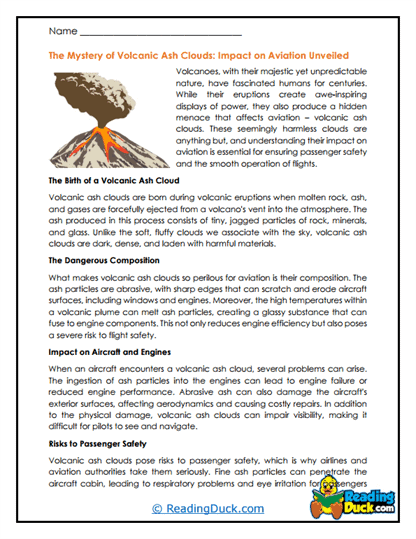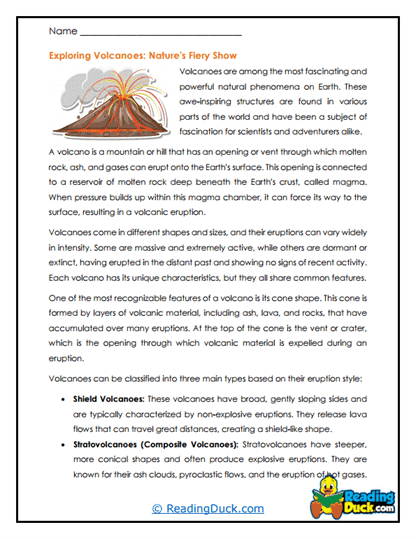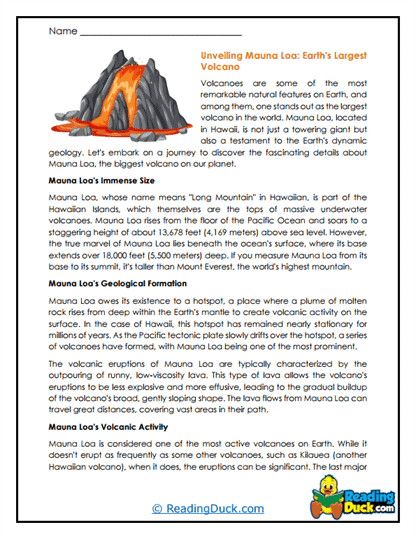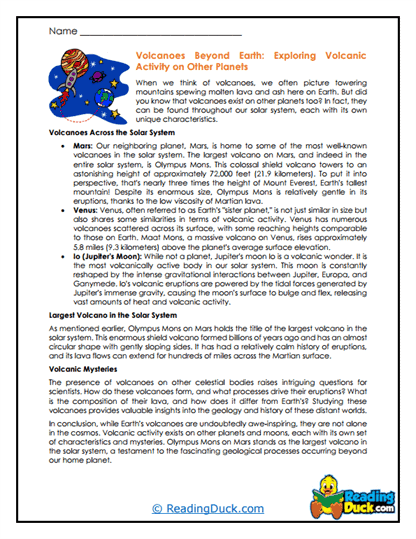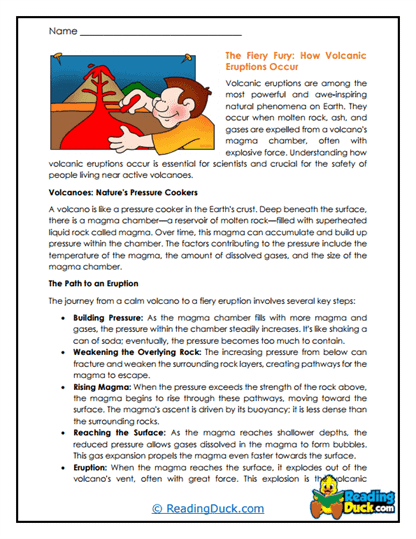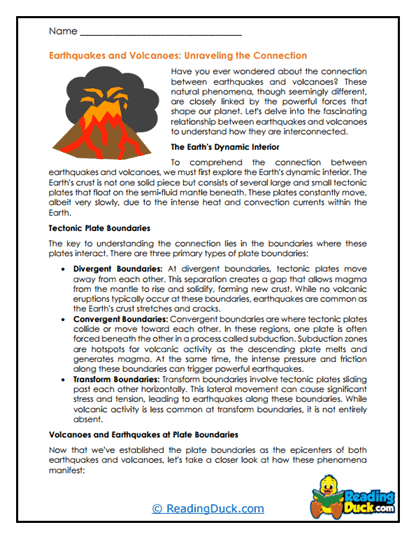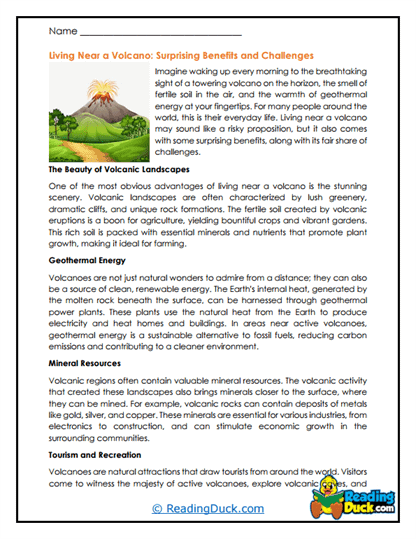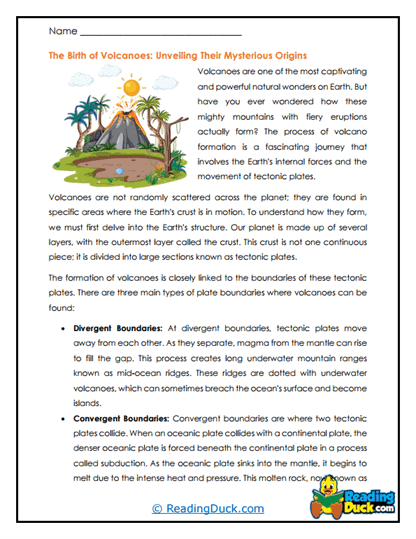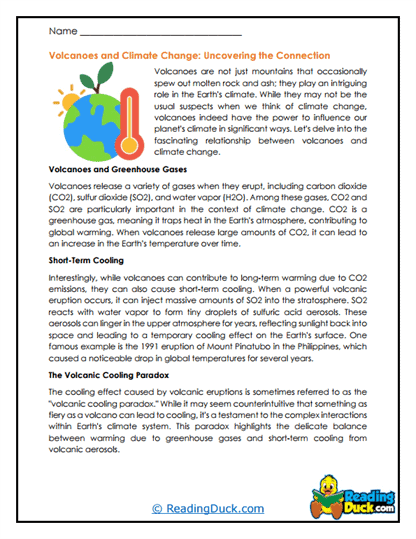Volcanoes Worksheets
About Our Volcanoes Worksheets
Our Volcanoes worksheets offer a comprehensive and engaging exploration of one of Earth’s most dynamic and fascinating natural phenomena. As a subtopic under Earth Science, these worksheets delve into the various aspects of volcanoes, from their formation and types to the impact they have on our planet and society.
Each worksheet set in this collection includes:
- Multiple Choice Questions: These questions reinforce key concepts from the reading passages, helping students solidify their understanding of the material.
- Short Answer Questions: These encourage students to articulate their knowledge in their own words, demonstrating their comprehension of volcanic processes and related topics.
- Open-Ended Questions: These prompt students to think critically and express their personal insights or opinions about the information they have learned, fostering deeper connections with the subject matter.
All worksheets are provided with answer keys and are available as easily accessible PDF files, perfect for both electronic use and print.
Exploring the World of Volcanoes: Understanding Earth's Fiery Mountains
1. What Are Volcanoes?
- Definition and Basic Structure:
- Volcanoes are openings in the Earth's crust through which molten rock, gases, and ash escape to the surface. These geological structures can take various forms, including mountains, fissures, and calderas, depending on their eruption styles and geological settings.
- The basic structure of a volcano includes the magma chamber, where molten rock accumulates beneath the Earth's surface; the main vent, through which magma reaches the surface; and the crater, a bowl-shaped depression at the top of the volcano.
- Formation of Volcanoes:
- Volcanoes form primarily at tectonic plate boundaries, where plates either diverge, converge, or slide past one another. At divergent boundaries, such as mid-ocean ridges, magma rises from the mantle as plates pull apart. At convergent boundaries, where one plate subducts beneath another, magma forms as the subducted plate melts. Volcanoes can also form over mantle plumes or "hot spots," where magma from deep within the Earth rises through the crust.
2. Types of Volcanoes
- Shield Volcanoes:
- Shield volcanoes are broad, gently sloping structures formed by the eruption of low-viscosity lava that can flow over great distances. These volcanoes tend to have non-explosive eruptions and are typically found at hot spots, like the Hawaiian Islands.
- Stratovolcanoes (Composite Volcanoes):
- Stratovolcanoes are large, steep-sided volcanoes composed of alternating layers of solidified lava, ash, and other volcanic debris. These volcanoes are often associated with explosive eruptions due to the higher viscosity of their magma. Famous examples include Mount Fuji in Japan and Mount St. Helens in the United States.
- Cinder Cone Volcanoes:
- Cinder cones are the smallest type of volcano, formed from the accumulation of volcanic debris such as ash, cinders, and volcanic rocks. These volcanoes have steep slopes and typically result from short-lived eruptions.
- Calderas:
- Calderas are large, basin-like depressions formed when a volcano's summit collapses after a massive eruption. These structures can be tens of kilometers wide and are often filled with water to form lakes, such as Crater Lake in Oregon.
3. Volcanic Eruptions and Their Effects
- Types of Eruptions:
- Effusive Eruptions: These eruptions involve the steady flow of lava onto the surface, forming extensive lava fields. Effusive eruptions are common in shield volcanoes.
- Explosive Eruptions: Characterized by the violent ejection of ash, gas, and volcanic bombs, explosive eruptions can be devastating, ejecting material high into the atmosphere and affecting large areas.
- Phreatomagmatic Eruptions: These eruptions occur when magma comes into contact with water, leading to highly explosive steam-driven explosions.
- Impact on the Environment:
- Volcanic eruptions can drastically alter landscapes, destroy habitats, and impact climate. Large eruptions can inject vast quantities of ash and gases into the atmosphere, leading to short-term climate cooling due to the reflection of sunlight away from the Earth's surface.
- Impact on Human Societies:
- Historically, volcanic eruptions have had profound effects on human civilizations, from the destruction of cities like Pompeii to influencing global climate and agriculture. Understanding volcanoes is crucial for disaster preparedness and mitigating the risks associated with living near these natural features.
The Significance of Studying Volcanoes: Insights into Earth’s Dynamics
1. Understanding Earth’s Interior:
- Studying volcanoes provides crucial insights into the processes occurring deep within the Earth. By examining volcanic rocks and gases, scientists can infer the composition and behavior of the Earth's mantle and the dynamics of tectonic activity.
2. Predicting Volcanic Eruptions:
- Research in volcanology aims to improve our ability to predict volcanic eruptions, thereby reducing the risks to human life and property. Understanding the signs of an impending eruption, such as seismic activity, ground deformation, and gas emissions, is vital for issuing timely warnings and evacuations.
3. Volcanic Hazards and Risk Management:
- Volcanoes pose various hazards, including lava flows, pyroclastic flows, ashfall, and lahars (volcanic mudflows). Effective risk management involves monitoring active volcanoes, developing hazard maps, and implementing land-use planning and emergency response strategies.
4. The Role of Volcanoes in Earth’s Evolution:
- Volcanic activity has played a significant role in shaping Earth’s atmosphere and surface over geological time. Volcanic outgassing contributed to the formation of Earth’s early atmosphere, and volcanic islands have provided new land for ecosystems to colonize.
Activities to Supplement These Worksheets
To enhance the learning experience provided by the Volcanoes worksheets, here are some engaging activities and projects that teachers and parents can incorporate into their lessons:
1. Model a Volcano Eruption
- Objective: Demonstrate the process of a volcanic eruption and the different types of lava flows.
- Activity: Using materials like baking soda, vinegar, and clay, students can create their own model volcanoes. They can simulate an eruption by combining the baking soda and vinegar, observing how the "lava" flows down the sides of their model. This hands-on activity helps students visualize volcanic processes and understand the factors influencing the shape and size of different types of volcanoes.
2. Volcano Research Project
- Objective: Encourage students to explore specific volcanoes in detail, learning about their history, eruptions, and impacts.
- Activity: Assign each student a well-known volcano to research, such as Mount Vesuvius, Krakatoa, or Mauna Loa. Students can present their findings through a report, poster, or slideshow, highlighting key details like the volcano’s type, eruption history, and its effects on local communities and environments.
3. Create a Volcanic Hazard Map
- Objective: Understand the risks associated with living near a volcano and how to mitigate them.
- Activity: Students can create a hazard map for a specific volcano, identifying areas at risk from lava flows, ashfall, and other volcanic hazards. They can also propose safety measures and evacuation routes, discussing how communities can prepare for a potential eruption.
4. Virtual Field Trip to a Volcano
- Objective: Explore volcanic landscapes and features through virtual resources.
- Activity: Use online resources like Google Earth or virtual tours provided by national parks and geological organizations to take students on a virtual field trip to a volcano. They can explore different volcanic features, such as craters, lava tubes, and calderas, while learning about the geology and history of the area.
5. Debate on Volcanic Eruption Preparedness
- Objective: Develop critical thinking and argumentation skills while exploring the challenges of disaster preparedness.
- Activity: Organize a classroom debate on the topic of volcanic eruption preparedness. One group of students can argue for increased investment in monitoring and early warning systems, while another group can discuss the importance of community education and infrastructure improvements. This activity helps students understand the complexities of managing volcanic risks.
6. Creative Writing: A Day in the Life of a Volcano
- Objective: Encourage creative thinking while reinforcing scientific concepts.
- Activity: Ask students to write a short story or diary entry from the perspective of a volcano. They can describe their "life," from formation to eruption, incorporating scientific details about the rock cycle, magma movement, and volcanic eruptions. This exercise allows students to engage with the material in a creative and imaginative way.
7. Construct a Volcano Timeline
- Objective: Learn about the history and evolution of volcanoes over time.
- Activity: Students can create a timeline that traces the major eruptions of a particular volcano or a series of notable volcanic events throughout history. This timeline can include details about the eruption, its magnitude, and its impact on the environment and human societies.
By integrating these activities with the Volcanoes worksheets, educators and parents can provide a well-rounded and immersive learning experience. These projects and activities not only reinforce the scientific concepts covered in the worksheets but also foster a deeper appreciation for the power and beauty of Earth's geological processes. Through hands-on exploration, research, and creative expression, students can gain a comprehensive understanding of volcanoes and their role in shaping our planet.
